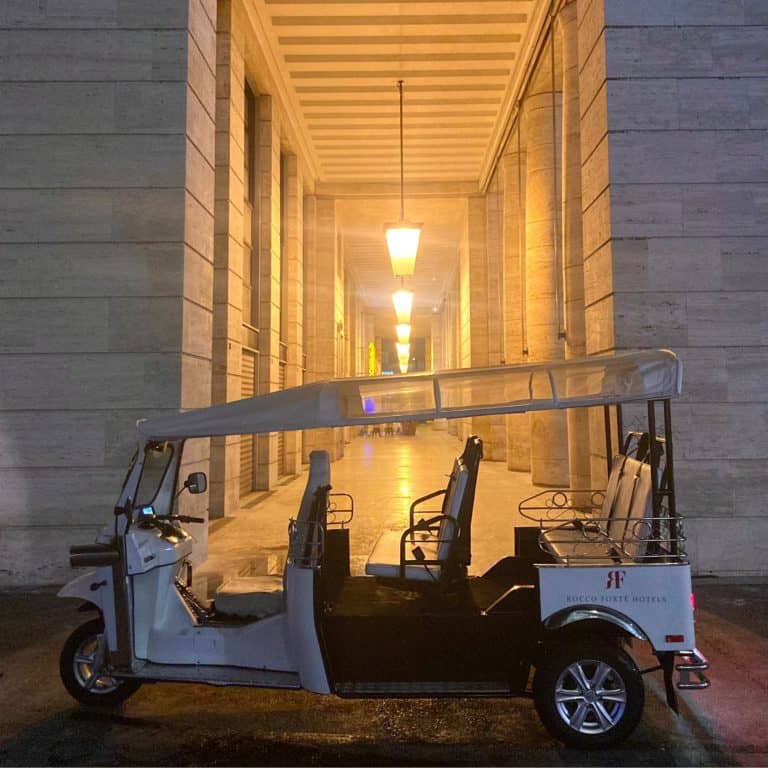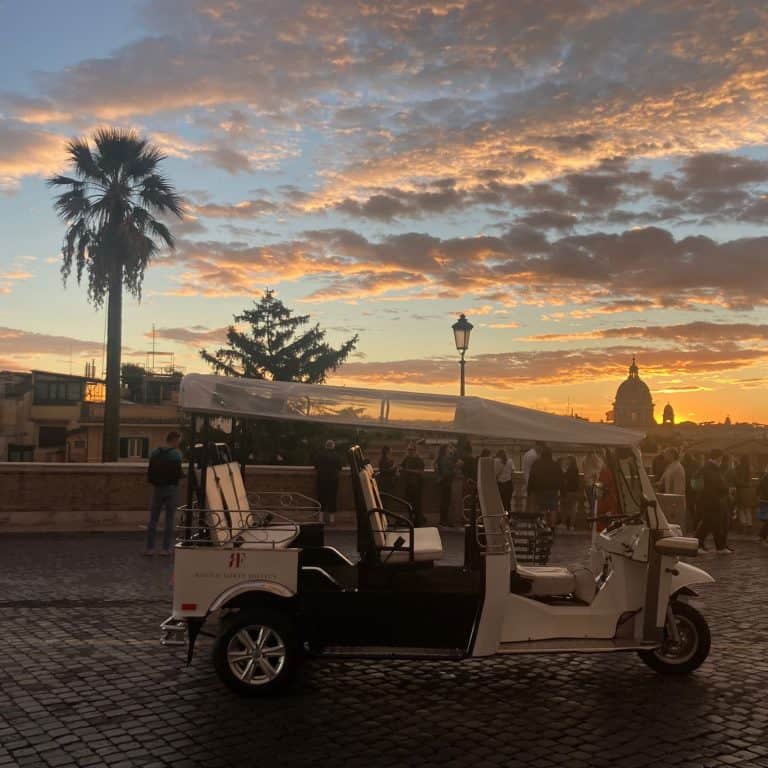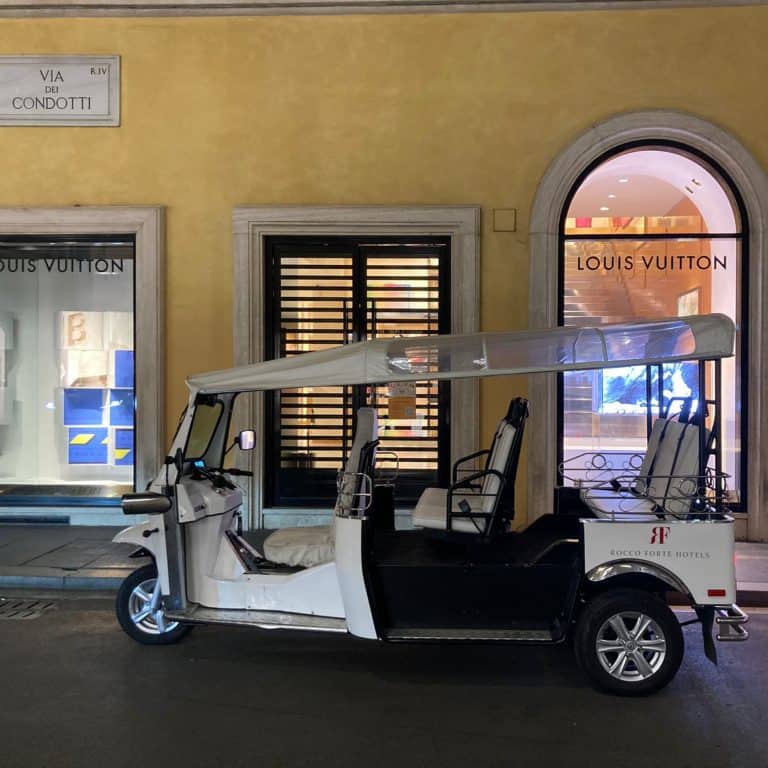Rome Evening Tour by Golf Cart
What type of tour is this?
PrivateHow long is the duration of the tour?
2 HourHow long is the tour in kilometers?
15 km
Experience the magic of Rome by night on our 2-hour Evening Tour of Rome by Golf Cart.
Our expert driver guide takes you to two of the most breathtaking spots overlooking the cityscape: Passegiata del Pincho and the Garibaldi Monument.
Description
Witness the city’s iconic landmarks bathed in the soft glow of twilight as you wander through its historic streets. Let the bustling energy of the city by day transform into a peaceful elegance by night. Don’t miss this opportunity to see Rome in a whole new light.
Enjoy the city’s most breathtaking spots with stunning views overlooking the city from up high—the Passegiata del Pincho and the Garibaldi Monument.
Book our unforgettable evening tour of Rome by Golf Cart now and create magical memories that will last a lifetime.
Meeting Point
What's included?
- Private transportation
What's not included?
- Food & drinks
- Snacks
What to bring?
- Weather-appropriate clothing
Not Suitable For?
What to know before you go:
- Not wheelchair accessible
- Not stroller accessible
- Not suitable for pets
- Infants must not sit on laps
- Infant seats unavailable
Cancelation Policy
Itinerary Route

Piazza del Popolo
We stop near the magnificent entrance gate now called the porta del Popolo and formerly known as the Porta Flaminia). We can admire the ellipse shaped square with in the center one of the best preserved obelisks of Rome. It was the first obelisk brought to Rome by Augustus. From the piazza three straight roads lead into town, we call this the tridente (trident): via del Babuino, via del Corso and via di Ripetta. For art lovers we suggest to have a glimpse insight the Santa Maria del Popolo where one can admire 2 paintings of Caravaggio. The piazza del Popolo is still one of the liveliest squares of Rome.
Piazza Augusto Imperatore
The severe architecture from the thirties of the last century is now hosting the famous luxury Bulgari hotel and the squared shapes embrace the round shaped mausoleum of Augustus the first emperor of Rome. Build by Augustus in 28 BC. After the fall of the Roman empire it was sacked and later used as fortress and also as a concert hall. The square is now under construction.
Via Condotti the famous shopping street
Via Condotti’s original name was the Via Trinitatis because it led directly to the Trinità dei Monti, on top of the Spanish Steps. The first origins of this road, crossing the current Via del Corso, date back to the time of Augustus. It is only in the 16th century that the name Condotti appears due to the ‘water conducts’ that formed part of the Roman acquaduct ‘Acqua Vergine’. During the Baroque period, this district acquired more fame and glory. In 1760, the famous ‘Antico Caffè Greco’ was opened. Since the end of the 18th century, the street has always been a luxury shopping street that attracted all the famous brands like Prada, Bulgari, and Gucci.
Piazza Sant Ignazio
This elegant square, built in the Rococo style (Roman baroque), hosts the Jesuit church dedicated to the saint Ignazio from Loyola. The church dates back to the first half of the 1600s. The al fresco in the central nave is a stunning ‘trick on the eye’ by Andrea Pozzo. If you stand in the center in front of the church and look to the other side of the square, you can admire three oval facades that together seem to form one united building; however, a road appears to penetrate the building, another ‘trompe l’oeil.’
Piazza Navona
Piazza Navona, originally the Stadium of Domiziano (also the Circus Agonalis), was commissioned in 80 AD by emperor Domitianus. The stadium accommodated 30.000 spectators, and this is where the Romans imitated the Olympic Games (agonalis: agony). The current square was built under the Pamphili Pope Innocent X, who commissioned the impressive building that now hosts the embassy of Brazil.
Under the same pope, the church Sant Agnese in Agone was built, followed by the famous Four River Fountain in the centre with on top of it the 17-meter tall obelisk. The fountain was designed and partially sculpted by Gian Lorenzo Bernini around 1650. Two other fountains, the Fountain of the Moor and the Fountain of Neptune, complete the elegant Renaissance Piazza Navona. We will stop here for a short walk, and a coffee or toilet break is possible here.
Campo dei Fiori
The lively Campo dei Fiori originated in the 15th century and was grown organically with homes from the late Middle Ages and early Renaissance period. The somehow chaotic appearance is also its charm, and the square hosts a market every day of the week until 15.00. From this hour, it transforms into a lively square where locals and tourists gather due to the many trattorie and bars. In the centre of the square is the dark statue of Giordano Bruno, who was burned here in 1600 for believing that the universe is infinite. On one of the corners is a very good bakery named Forno, where you can buy one of the best-sliced pizzas ready to take away.
Saint Peters Square / Vatican
The Saint Peters square is the cradle of the Christian world. When we park and walk on the square, what first strikes you are the gigantic columns totalling 284, designed by Gian Lorenzo Bernini around 1660. The origin of the square dates back to the time of Caligula and Nero, when they had built a giant circus for horse-running with chariots. The area was also used to execute Christians, blaming them for the great fire of 64 AD. The square is believed to be where Saint Peter was crucified (upside down).
The Basilica of Saint Peter was an ongoing change process during the 16th and 17th centuries. The most significant artists of that time were used, like Michelangelo, Bernini, Giacomo della Porta, and Domenico Fontana. The obelisk in the centre dates back to the time of Caligula and is one of the tallest and the only one in the same district during the time.
Gianicolo Hill
The Gianicolo Hill is named after the two-faced God Lanus or Giano. It is one of the highest hills in Rome (88 meters). The Gianicolo hill is on the right side of the Tiber River and was originally an Etruscan location. In the 5th century BC, the hill was conquered by the Romans. The hill was included in the walls built by Aurelio in the 3rd century AD. The wealthy and important families of Rome, like the Doria Pamphili and Corsini, had their villas on the hill. Thanks to them, we still have one of the largest public parks in Rome, the Villa Pamphili. The hill was also the scene of a ferocious battle in 1849 where Garibaldi was fighting for the independence of Rome against the French. In 1904 a big canon was placed on the highest point and since then the canon fires a loud shot exactly at 12.00 to align all the church bells of Rome. If you happen to be there just before 12.00, make sure you have a nice spot on the higher wall from where you can see some military members executing this tradition.
Piazza Garibaldi
Garibaldi Square is considered the best place to admire the eternal city. Below the balcony, you can see the botanical garden, and you look out over Trastevere, the historic center, on a clear day. You can admire the Apennine mountain range, which can be covered with snow in winter.
The Fontanone or Mostra dell’acqua Paola)
The Fontanone is what the Romans call this magnificent fountain meaning ‘the big fountain’. Commissioned by Pope Paolo V, a Borghese Pope. This fountain was the end point of the Trajan-Paolo aqueduct that was destroyed and Pope Paul the V took on the job to restore this water source to provide the lower Trastevere district with drinking water. This gesture made him very popular.
Santa Maria in Trastevere
The Trastevere district may be the most well-known district by tourists. It means ‘on the other side of the Tiber.’ Dating back to the beginning of the foundation of Rome around 700 BC, the district was always important to control the Tiber River. It was also where the first Jewish synagogue was built in 980, and therefore, it was an important Jewish district until the late Middle Ages. From this time onwards, the district, with its narrow streets, became a poor district and was often flooded by the Tiber, and it was, therefore, not a healthy place to live. The main feature of the district is the beautiful Santa Maria in Trastevere, one of the first basilicas of Rome. We will glide through this district and stop for an ice cream.
Gelato Trastevere
People always ask us where to eat the best ice cream in Rome, the famous ‘gelato’. Personally, we can recommend the ‘Fonte della Salute’ on the less touristy side of the Trastevere district. Since 1980, this ice cream shop has made authentic ice cream with the best ingredients. The pistachio ice cream is sublime.
Tiber Island
The Tiber Island can be associated with the origins of Rome, being a natural bridge from the left bank to the right bank. The Tiber Island permitted important trade routes to connect both sides of the river. The vegetable and fish markets were already here in the time of the Roman Republic. The oldest bridge in Rome is the Ponte Fabricio, which dates back to 62 BC. In 1877, the large walls were built to avoid inundations that had caused many problems for centuries. On Tiber Island, we can find a hospital (Fatebenefratelli), the Sant Bartolomeo Church, the Sora Lella Restaurant, and the Tiberino bar-restaurant. During summertime, the island is covered with stands and bars and, since 1995, has hosted a huge outdoor cinema.
The Roman Forum
The Roman Forum can be considered the cradle of the Western world. The location already became important around 700 BC, and for centuries after, it has been the center of day-to-day life. We can glimpse Capitol Hill, where one of the first temples, the temple of Jupiter, was built. From 700 BC until 600 AD, constructions were added or altered in this rectangular area. We can admire almost 2000 years of history here, and from our stop, we can see the original layer of Rome that is about 8 meters below the current surface. We drive along the Forum and the Palatine Hill towards the Circus Maximus.
Bocca della Verità / Mouth of Truth
The Bocca della Verità can be recognized by the long waiting lines with people who want to get a photo of their hand placed in a round-shaped stone’s big mouth. The legend of the Mouth of Truth dates back to 1485 and tells that the mouth of the stone could eat your hand if you did not tell the truth, therefore ‘mouth of truth’. The stone was placed at the Santa Maria in Cosmedin church entrance in 1632. The stone was most likely used in Roman times as the cover of a water well. The stone became World famous due to the film ‘Vacanze Romane’ (Roman Holiday) with Gregory Peck and Audrey Hepburn.
The Orange Garden/Aventine Hill
The Orange Garden is one of the most romantic spots in Rome. Located right next to the ancient basilica of Santa Sabina, the gardens offer a nice spot to relax on w warm day, but they also offer one of the best panoramic views over Rome from its large balcony. We look out through the Roman pine trees on the Saint Peters Dome. A quick visit to the Santa Sabina basilica is a must with its original wooden door dating back to the early 5th century.
The Circus Maximus
The Circus Maximus is considered the largest stadium ever built. At the time of Trajan, it could host over 200.000 spectators. It was already used in the Republic (400 BC) for the chariot races. It was Julius Caesar that started the creation of walls around the circus. The large field is about 600 meters long and 140 meters wide. From where we will stop you can admire the circus and also the Palatine hill. Today, the field is still used for recreational purposes and hosts many concerts and festivals.
The Colosseum / Flavian Amphitheatre
The Colosseum’s original name is the Flavian Amphitheatre. Maybe the most famous monument in the world. Built between 70 AD and 80 AD to host the gladiator games. It fitted 50.000 spectators. The Colosseum was covered in marble and statues. It has been in use until 438 AD for almost 400 years. The name Colosseum derives from the gigantic golden statue that Nero had placed right even before the Colosseum existed. This statue was 30 meters tall and called a ‘colossus’. The amphitheater took on the name of the statue.
Piazza Venezia / Venice Square
Venice Square is Rome’s busiest and most chaotic square, but there is a lot to admire. We will show you the entrance steps towards Capital Hill, with the Basilica of Santa Maria in Aracoeli right next to it, dating back to the 6th century AD. The entrance has a Roman Gothic appearance. Below the basilica, we will find the ruins of a Roman Insula dating back to the 2nd century AD. We will pass in front of the Vittoriano, a massive monument seen from all the hills of Rome. Built in honor of King Vittorio Emanuele II, it finished in 1911. It is for sure the most discussed building in Rome.
Theatre of Marcellus
Julius Caesar started the Theatre of Marcellus, but he was murdered, and Augustus finished it in 17 BC. He named it after his nephew Marcellus, who died young of illness. The theatre had a capacity of 15.000 seats and was operational until the 4th century. The Savelli family built houses on top of it, and later, they were bought by the Orsini family, who still owns them.
Jewish Ghetto
From the Theatre of Marcellus, one can enter the Jewish quarter; the Ghetto is one of the most characteristic neighborhoods of Rome, always quiet with its narrow streets. After Venice, the second oldest Ghetto (1555). Despite its tragic and painful history, it is now a vibrant part of the geographical heart of Rome. Known also for its Roman-Jewish cuisine. We will show you some very particular streets and archeological sites.
Pantheon
The Pantheon is the best-preserved building from the Roman Empire. The mixture of round and square shapes and massive columns make it one of the most fascinating buildings of Rome. Built under Augustus by his friend and right hand Agrippa. A fire destroyed the building, and the Pantheon was reconstructed under Hadrian. After the fall of the empire, the building was transformed into a church in 609 AD. To get inside, you need a ticket, and you can admire the fantastic domed ceiling with a big hole of almost 9 meters. The surrounding square, the Piazza delle Rotonda, offers very charming buildings, an obelisk, and a fountain.
The Trevi Fountain
Known in the entire world, the Trevi Fountain was built in 1732 and designed by Nicola Salvi under the rule of Pope Clement XII. The name derives from three roads that would come together to the square where the fountain is. The still-working Vergine aqueduct provides the fountain with water. The fountain became known worldwide in 1960 because of the movie La Dolce Vita with Anita Ekberg and Marcello Mastroianni.
The Spanish Steps / Trinità dei Monti
The Spanish Steps were built between 1723 and 1726 by Francesco de Sanctis to connect the upper Pincio hill with the Piazza di Spagna. The name derives from the Spanish Embassy down the steps on the square. For many years, the steps were a place where people would gather and sit, serving as a famous meeting point. It has lost that function, but it is always an elegant place to enter glamorous shopping streets like Via Condotti. On top of the steps, we find the Santissima Trinità dei Monti church, founded by Francesco de Paola in 1494. You have a great view over Rome and the Vatican City from where the obelisk stands.
Villa Borghese
The Villa Borghese Park covers a large area not far from the city center. The park belonged to the powerful Borghese family, and the villa (mansion) was built in 1633 to host the extensive collection of art from the Borghese family. The Italian state bought the park in 1903, and the villa is now one of the finest museums in Rome. The end of the park above Piazza del Popolo, the so-called Pincio, offers unique views over the square and the Vatican City. The sunsets are breathtaking here.












